History
The church is dedicated to the holy martyrs Hippolytus and Lawrence. According to tradition, it was built on the house of the centurion Hippolytus, where the deacon Lawrence was held prisoner. Lawrence miraculously sprung a source of water, still visible in the basement of the building, with which he baptized his cellmate Lucillus, restoring his sight at the same time; in the face of the miracle, Hippolytus would have converted to Christianity and was being baptized in turn. [1]
The origin of the church is unknown. Sometimes it is confused with another one, no longer extant, called Memoria Sancti Hippoliti, already mentioned in 4th century, whose title was joined to the current one.
The church is mentioned for the first time in a document preserved in the Archive of Santa Maria Maggiore and dated May 28, 1348; in 13th and 14th century it was inhabited by Benedictine monks and nuns.
The present church was built in 1543 by commission of the Spanish cardinal Juan Álvarez de Toledo. In 1624, Pope Urban VIII had enlargement works carried out by the architect Domenico Castelli, called il Fontanino, a nephew of Carlo Maderno.
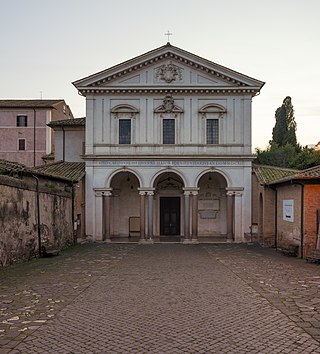
San Sebastiano fuori le mura, or San Sebastiano ad Catacumbas, is a minor basilica in Rome, Central Italy. Up to the Great Jubilee of 2000, San Sebastiano was one of the Seven Pilgrim Churches of Rome, and many pilgrims still favour the traditional list.

San Martino ai Monti, officially known as Santi Silvestro e Martino ai Monti, is a minor basilica in Rome, Italy, in the Rione Monti neighbourhood. It is located near the edge of the Parco del Colle Oppio, near the corner of Via Equizia and Viale del Monte Oppio, about five to six blocks south of Santa Maria Maggiore.

Santa Caterina a Magnanapoli is a baroque church dedicated to St. Catherine of Siena on Largo Magnanapoli on the slopes of the Quirinal Hill in Rome.

The Chiesa di Santa Rita da Cascia in Campitelli is a deconsecrated church in Rome (Italy), in the rione Sant'Angelo; it is located in Via Montanara, at the crossroad with Via del Teatro Marcello. The church formerly rose on the preexisting church of San Biagio de Mercato, dating at least to the 11th-century. The remains of St Blaise putatively were discovered during the dismantling of Santa Rita.
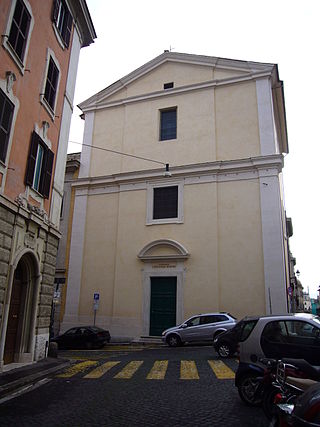
San Bernardino in Panisperna or Panispermia or San Bernardino ai Monti or San Bernardino da Siena ai Monti is a small Roman Catholic church in Rome. It is found across from the church of Sant'Agata dei Goti on via Panisperna in the Rione Monti.

San Giacomo alla Lungara is a church in Rome (Italy), in the Rione Trastevere, facing on Via della Lungara. It is also called San Giacomo in Settimiano or in Settignano, due to its vicinity to Porta Settimiana, built by Septimius Severus and included by Aurelianus within the city walls.

Santa Croce alla Lungara is a church in Rome (Italy), in the Rione Trastevere, facing on Via della Lungara. It is also called Santa Croce delle Scalette', due to the presence of a double flight of stairs giving access from the street; or Buon Pastore, since in the 19th century the church and the annexed cloister were entrusted to the Sisters of the Good Shepherd of Angers.

Santo Spirito dei Napoletani is a Roman Catholic church on via Giulia, in the Regola rione of Rome. It was the national church of the Kingdom of the Two Sicilies and is now the regional church for Campania.

San Giovanni Battista dei Genovesi is a Roman Catholic church on via Anicia in the Trastevere district of Rome. It is the regional church for Genoa.

Santissimo Sudario all'Argentina or Santissimo Sudario dei Piemontesi is a church in Rome, sited on the via del Sudario in the Sant'Eustachio district. It is the subsidiary church of the military orders in Italy. It was also once the national church of the Kingdom of Sardinia and is now the regional church for Piedmont and Sardinia. It houses a replica of the Turin Shroud.
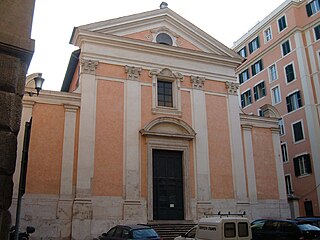
Santa Croce e San Bonaventura alla Pilotta or Santa Croce e di San Bonaventura dei Lucchesi is a church in Rome, sited on via dei Lucchesi in the Trevi district, between the Trevi Fountain and the Pontificia Università Gregoriana. It is Lucca's regional church in Rome.

Santa Maria della Concezione is a church in Rome, located on Piazza Campo Marzio in the Campo Marzio rione. It serves as the national church in Rome for Syriac Catholics.

San Salvatore alle Coppelle is a church in Rome, on piazza delle Coppelle in the Sant'Eustachio district.

Sant'Antonio abate all’Esquilino is a church in Rome, located near the Basilica of Santa Maria Maggiore on via Carlo Alberto in the Esquilino district.
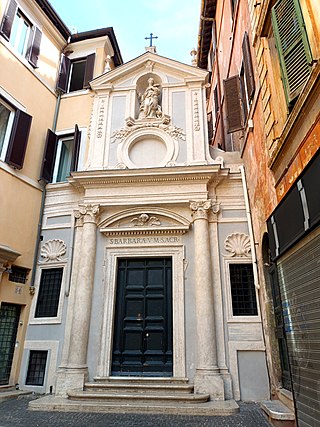
Santa Barbara dei Librai is a small Roman Catholic church in Rome, Italy. It was once known as Santa Barbara alla Regola after the rione in which it was located. Today it now considered within the rione of Parione, near the Campo de' Fiori.

Santa Maria in Monterone is a Roman Catholic church in Rome, Italy. Its suffix originates from the Sienese Monteroni family, whose patronage rebuilt the church and built a small hospice next to it for pilgrims from Siena. It is located on Via Santa Maria in Monterone in the Sant'Eustachio rione. Next to the church is a Redemptorist monastery, whose clergy manage the church.

Santa Maria in Montesanto is a titular minor basilica church in Rome, in the Rione Campo Marzio, which stands in Piazza del Popolo, between Via del Corso and Via del Babuino. It is also known as the Church of the Artists. The church is popularly known as the twin church of Santa Maria dei Miracoli, though it shows significant differences especially in the planimetry.

Santi Andrea e Bartolomeo is a Catholic church in Rome (Italy), in the Rione Monti, on Via Santo Stefano Rotondo.

The church of Santa Galla was a church in Rome (Italy), in the Rione Ripa, on the road that connected Piazza Montanara with Piazza della Bocca della Verità. Both the church and the square in front of it were destroyed between 1928 and 1930 for the construction of the first stretch of Via del Mare ; the furnishings and the altar were relocated to the new church of Santa Galla at Garbatella, built in 1940.
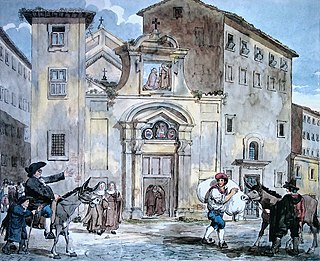
Sant'Urbano a Campo Carleo was a church in Rome (Italy), in the Rione Monti, on the former Via Alessandrina.






















